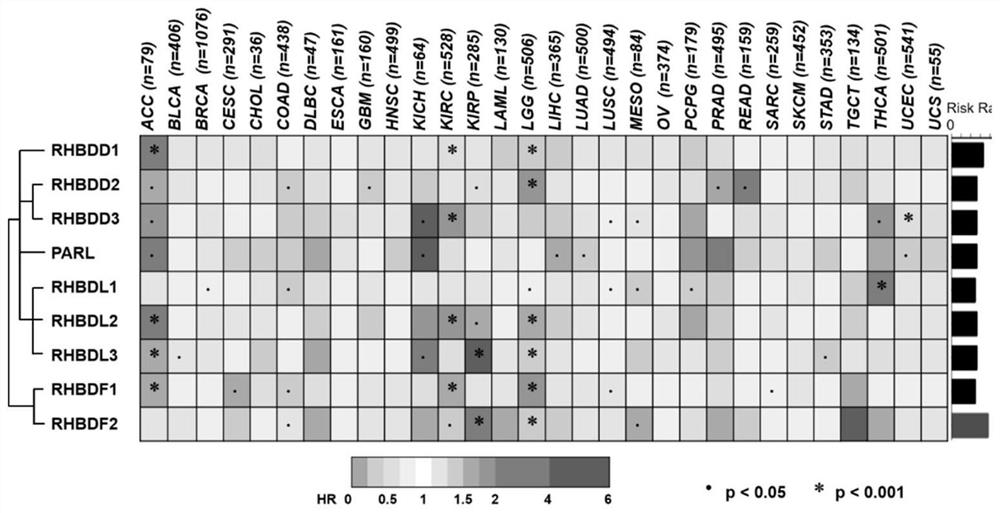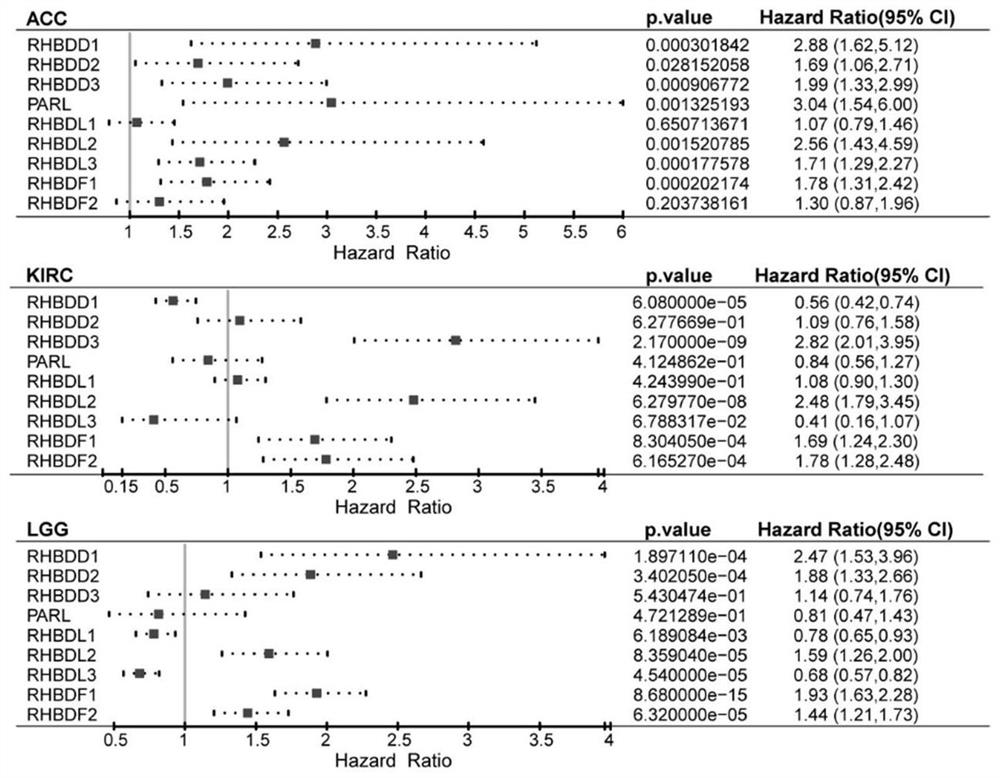Renal clear cell carcinoma biomarker and application thereof
A technology of clear cell renal cell carcinoma and gene markers, which is applied in the field of genetic detection of clear cell renal cell carcinoma, can solve problems such as the failure to form a prediction model, and achieve the effect of avoiding excessive medical treatment and inhibiting the proliferation and migration of clear cell renal cell carcinoma
- Summary
- Abstract
- Description
- Claims
- Application Information
AI Technical Summary
Problems solved by technology
Method used
Image
Examples
Embodiment 1
[0045] Example 1: Screening of gene signatures associated with clear cell renal cell carcinoma
[0046] First, the transcriptome sequencing data and clinical information of 30 cancers were obtained from the TCGA database, and the gene expression data of the human rhomboid protein family and patient survival data were extracted for single-factor COX analysis to obtain the hazard ratio (HR) related to gene expression. , the analysis results were tested using log-rank test for significance, figure 1 It is a graphical COX analysis result. exist figure 1 The bar chart on the right counts the proportion of each gene in adverse risk in 30 cancers, among which RHBDF2 has a higher risk. Overall, the cancers in which patient survival was significantly influenced by gene expression across the family were adrenocortical carcinoma (ACC), low-grade brain glioma (LGG), and kidney renal clear cell carcinoma. carcinoma, KIRC). figure 2 The results of the risk analysis for the three cancer...
Embodiment 2
[0048] Example 2: Relationship between patients with high RHBDF2 expression and clinical features of renal clear cell carcinoma
[0049] The RHBDF2 expression data of patients with clear cell renal cell carcinoma downloaded from the TCGA database were matched and compared with the clinical data, grouped according to the expression level of RHBDF2, and divided into RHBDF2 high expression group and RHBDF2 low expression group with the median of RHBDF2 expression as the boundary, The age level, tumor stage, pathological grade, metastasis and lymphatic metastasis of patients in each group were counted. As shown in Table 1, the average age at diagnosis of clear cell renal cell carcinoma is 60 years old, and the age at diagnosis of patients with high RHBDF2 expression is mostly lower than the average age of 60 years. Compared with the group with low RHBDF2 expression, there are more Patients with high-grade tumors and advanced disease also had more metastases. The chi-square test w...
Embodiment 3
[0054] Example 3: The expression of RHBDF2 is positively correlated with the immune infiltration level of renal clear cell carcinoma
[0055] A high level of immune infiltration is one of the characteristics of clear cell renal cell carcinoma. In renal cancer, the state of immune cell infiltration has a great impact on the treatment response and disease progression of patients. Highly immunosuppressive immune cell infiltration is not conducive to the improvement of patients' disease. Use the R package "ESTIMATE" to calculate the immune score of the patient sequencing data in the TCGA database and GSE68417, and then calculate the Pearson correlation coefficient between the expression of RHBDF2 and the immune score of each patient. The results are as follows Figure 6 A, B, RHBDF2 levels are positively correlated with immune scores.
PUM
 Login to View More
Login to View More Abstract
Description
Claims
Application Information
 Login to View More
Login to View More - R&D
- Intellectual Property
- Life Sciences
- Materials
- Tech Scout
- Unparalleled Data Quality
- Higher Quality Content
- 60% Fewer Hallucinations
Browse by: Latest US Patents, China's latest patents, Technical Efficacy Thesaurus, Application Domain, Technology Topic, Popular Technical Reports.
© 2025 PatSnap. All rights reserved.Legal|Privacy policy|Modern Slavery Act Transparency Statement|Sitemap|About US| Contact US: help@patsnap.com



